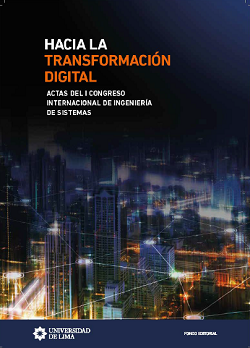Clinical information digitalization and structuring system using optical character recognition and natural language processing techniques
DOI:
https://doi.org/10.26439/ciis2018.5466Keywords:
optical character recognition, computer vision, natural language processing, international statistical classification of diseases, support vector machine, term frequency – inverse document frequencyAbstract
This work aims to develop a system that allows the digitization and structuring of clinical records written in a traditional fashion by a doctor using optical character recognition and natural language processing techniques, proving in a non-invasive workflow. In addition, it will enable the use of the generated data for future work.
Downloads
References
Biondich, P., Overhage, M., Dexter, P., Downs, S., Lemmon, L., y McDonald, C. (2002). A modern optical character recognition system in a real world clinical setting: some accuracy and feasibility observations. Recuperado de http://www.ncbi.nlm.nih. gov/pmc/articles/PMC2244242/
Candice, N. y Erasmus, L. (2016). Electronic Medical Records: A developing and developed country analysis. Recuperado de http://iamot2016.org/proceedings/ papers/IAMOT_ 2016_paper_32.pdf
Castro, H. y Pinedo, W. (2018). Sistema de digitalización y estructuración de información clínica con técnicas de reconocimiento óptico de caracteres y procesamiento de lenguaje natural. Tesis de pregrado. Universidad de Lima.
Charles, D., Meghan, G. y Searcy, T. (abril de 2015). Adoption of Electronic Health Record Systems among U.S. NonFederal. Recuperado de https://www.healthit.gov/sites/default/files/data-brief/2014HospitalAdoptionDataBrief.pdf
Dadhania, S., y Dhobi, J. (2012). Improved kNN Algorithm by Optimizing Cross-validation. International Journal of Engineering Research y Technology (IJERT) 1(3), pp. 1-6. Recuperado de http://www.ijert.org/download/135/improved-knn-algorithm-by-optimiz ing-cross-validation
Grother, P., y Hanaoka, K. (2016). NIST special database 19 hand printed forms and characters. (Segunda edición). Recuperado de National Institute of Standards and Technology:
https://s3.amazonaws.com/nist- srd/SD19/sd19_users_guide_edition_2.pdf
Hilbert, M. (2015). Digital technology and social change (Open Online Course at the University of California, freely available). Recuperado de https://canvas.instructure.com/courses/949415
Mickevicius, V., Krilavicius, T. y Morkevicius, V. (2015). Classification of short legal lithuanian texts. Recuperado de http://bpti.lt/wp-content/uploads/2016/02/bsnlp2015.pdf
Ouchtati, S., Redjimi, M., y Bedda, M. (2015). An offline system for the recognition of the fragmented handwritten numeric vhains. International Journal of Future Computer and Communication 4(1), pp. 33-39. Recuperado de http://www.ijfcc.org/vol4/351-C032.pdf
Perea, J., Martín, M., Montejo, A., y Diaz, M. (2008). Categorización de textos biomédicos usando UMLS. Procesamiento del Lenguaje Natural 40 (pp. 121-127). Recuperado de http://www.sepln.org/revistaSEPLN/revista/40/todo.pdf
Pradeep, J., Srinivasan, E., y Himavathi, S. (marzo de 2011). Neural Network based handwritten character recognition system without feature extraction. En: International Conference on Computer, Communication and Electrical Technology-ICCCET 2011, 18th y 19th March, (pp. 40-44). Recuperado de http://ieeexplore.ieee.org/document/5762513/
Rasmussen, L. V., Peissig, P., McCarty, C., y Starren, J. (junio de 2012). Development of an optical character recognition pipeline for handwritten form fields from an electronic health record. Recuperado de https://jamia.oxfordjournals.org/content /19/e1/e90
Stanford Natural Language Processing Group (2015). Spanish FAQ for Stanford CoreNLP, parser, POS tagger, and NER. Recuperado de https://nlp.stanford.edu/software/spanish-faq.shtml
Sun, H. (2015). k- Nearest Neighbour and SVM classifier with feature extraction and feature selection. Recuperado de http://homepages.rpi.edu/~sunh6/15fall6967.pdf


